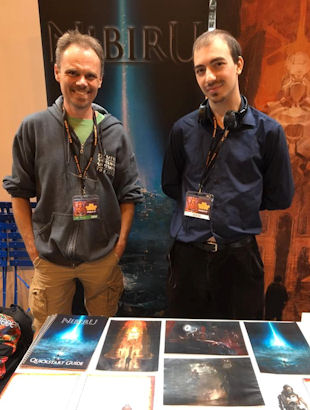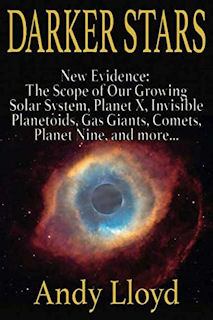Andy Lloyd's Dark Star Blog

Blog 85 (August-October 2021)
Pinning Down Planet Nine
The concept of Planet X has been around for maybe 150 years now, and has had its ups and downs. Five years ago, two very serious astrophysics academics pitched a new incarnation for this missing planet, which they renamed Planet Nine. Their astrophysics paper provided new indirect evidence for the existence of this object (1), and their confident espousal of their hypothesis was greeted with great media excitement across the world. Since then, the excitement generated by the seemingly imminent discovery of a significant new planet in the solar system has waned somewhat, largely due to the fact that it steadfastly refuses to appear for the many planet-hunting astronomers eager to make their name in the history books. Planet X is less rollercoaster in its ups and downs, more meandering jaunt across the Alps.
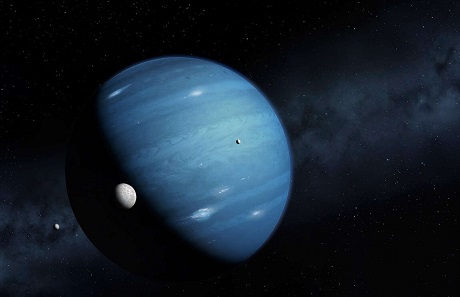
Image credit: Mark Garlick/Science Photo Library / via Getty Images
Planet Nine has also had its fair share of detractors (e.g. (2)). Again, this is nothing new in the Planet X story, the difference being in this case the eminence of Drs Brown and Batygin, both highly regarded Caltech academics in their respective specialisms of astronomy and celestial dynamics. But this is controversial subject, with many whacky off-shoots, so perhaps that's to be expected. Like other Planet X geeks, I've enjoyed taking a ring-side seat to watch the academic pitched battles waging between the Caltech Two and OSSOS through the scientific literature. I've written about it in my latest book "Darker Stars", the title of which could just as easily describe the human protagonists as the planets they hunt (3). You haven't exactly needed a telescope to spot the bared teeth on display in the recent past.
So, here we are in 2021, with no planet but still plenty of controversy. The latest paper to emerge from Caltech presents the most detailed thinking yet about the size, distance and probable location of Planet Nine. But before getting into that important detail, it first seeks to demolish the arguments put forward by Planet Nine detractors, particularly regarding observational bias:
"
In analyses of all available contemporary data and their biases, Brown (2017) and Brown & Batygin (2019, hereafter BB19) find only a 0.2% chance that the orbits of the distant Kuiper belt objects (KBOs) are consistent with a uniform distribution of objects... BB19 showed that data from the highly biased OSSOS survey, which only examined the sky in two distinct directions, do not have the sensitivity to detect the clustering already measured for the full data set." (4)Elsewhere, reports citing this work have suggested that the chance that this effect is a cosmic coincidence is just 0.4% (5). Now, I'm quite sure this knockabout scientific tennis match will continue for a while longer, but to my mind this is first 'set' to Caltech. The authors also turn their attention to the fact that the object has not yet been detected, and conclude that this must rule out some of the range of values which they had determined for Planet Nine's size and, most importantly, distance from the Sun. Effectively, if the planet had been lying in the nearer regions of space, then it should already have been detected. Instead, it stubbornly remains just a hypothetical planet, meaning that if it does exist then it lies in the more distant range of possibilities. Even that range should soon become entirely transparent to planet-hunting astronomers, however, when the Vera Rubin Observatory scans the relevant tract of sky (5). This wide-angle lens 8.4 metre telescope is currently being built in Chile. So this should put the whole thing to bed once and for all! (Not...)
"Much of the predicted magnitude range of Planet Nine is within the single-image detection limit of the LSST survey of the Vera Rubin telescope, r ~ 24.3, though the current survey plan does not extend as far north as the full predicted path of Planet Nine." (4)
Brown and Batygin used complex computer simulations to work out the probable position of Planet Nine across the sky. I say across, because it is not possible to locate a point per se, merely a swathe of possible locations within a ribbon or strip of sky. Nonetheless, this is still narrowing down the possibilities significantly:
“Approximately 95% of the probability is within a swath of the sky that is ±12◦ in declination from an orbit with an inclination of 16◦ and an ascending node of 97◦ …” (4)
The uppermost image in the graphic below indicates Planet Nine's estimated position.
Image credit: M. Brown & K. Batygin (1)
The red curvy strip of potential cuts across a lot of sky, but seems to centre roughly on the constellation Taurus (rather than the previously favoured constellation of Orion):
"This maps very roughly to the sky near the constellation of Taurus, but again this is just a probable location. It could be anywhere in a broad swath of sky. That does make finding it difficult." (6)
Complicated further by the proximity of this Planet Nine location ribbon to the Milky Way:
"That area crosses the densely populated, sparkling plane of the Milky Way, which could have helped the planet hide during past searches." (7)
Having provided an improved range for Planet Nine's current location, they try to work our its luminous magnitude, based upon the following interesting supposition about what Planet Nine actually is:
"For masses between 4-20 Mearth we assume that the most likely planetary composition is that of a sub-Neptune, composed of an icy rocky core with a H-He rich envelope" (4)
While the distribution of possible positions is tightened up considerably, there is still a broad set of possible values of mass, distance and albedo (light reflectivity) for this possible world. Despite this breadth of possibility, the distribution of Planet Nine's probable sky position remains a constant throughout. So, astronomer now know where to search (roughly speaking), but it's still not clear how powerful a telescope would be needed to detect Planet Nine. That depends upon its size and albedo, providing a value for its relative magnitude.
As the authors note, given that Planet Nine remains in hiding the likelihood is that we can cross out some of the more luminous possibilities. Yet, the maths seems to favour a closer object than they first considered back in 2016, perhaps around 300 Astronomical Units (about ten time Neptune's distance). that means the orbital period has dropped from 18,500 years (their 2016 estimate) to more like 7,400 years (based upon the 2021 calculations) (7). We're back to Trujillo and Sheppard's initial proposal for a Planet X object back in 2014, which preceded Brown and Batygin's work on Planet Nine (8).
Will it ever be found? Mike Brown seems to think so, and remains an enthusiastic advocate for the existence of his remodelled version of Planet X:
“I think it’s within a year or two from being found,” says Mike Brown, an astronomer at the California Institute of Technology and an author of the new study, which has been accepted for publication in the Astronomical Journal. But, he adds, “I’ve made that statement every year for the past five years. I am super-optimistic.” (7)
The hunt for this object has got to be helped by the continuous flow of discoveries of extreme trans-Neptunian objects. The Dark Energy Survey has recently spotted another nine of these objects, whose orbits swing out beyond 150AU (9). The argument over whether these anomalous objects have been affected by an undiscovered Planet X object will continue to rage for a while at least.
Written by Andy Lloyd,
25th August - 21st October 2021
References:
1) K. Batygin & M. Brown "Evidence for a Distant Giant Planet in the Solar System" The Astronomical Journal, 151:2, 20 January 2016,
2) Napier, K. J., et al. “No Evidence for Orbital Clustering in the Extreme Trans-Neptunian Objects” February 2021
3) Andy Lloyd "Darker Stars" Timeless Voyager Press 2019
4) Michael Brown & Konstantin Batygin “The Orbit of Planet Nine” Submitted to AJ, 22 August 2021,
5) Brian Koberlein “If Planet 9 is out there, here's where to look” 30 August 2021
6) Phil Plait “Where to find Planet Nine? Here’s a treasure map” 24 August 2021
7) Nadia Drake “Planet 9 may be closer and easier to find than thought—if it exists” 31 August 2021
8) Chad Trujillo & Scott Sheppard "A Sedna-like body with a perihelion of 80 astronomical units" 27th March 2014, Nature, 507, 471-474,
9) Stephanie Pappas “Cosmic objects with strange orbits discovered beyond Neptune” 13 September 2021 with thanks to Lee
Theia and Pole Reversals
It is widely thought by scientists that our over-sized Moon was formed from an early collision between the Earth and a Mars-sized body - named Theia. It's considered to have happened very early on, when both planet-sized objects were proto-planets (1). Having knocked a chunk of Earth off, the resulting cosmic stream of debris went into orbit around the battered proto-Earth. It then coalesced to form the Moon.

This theory of Moon formation may also hold the key to another mystery - that of the Earth's intermittent magnetic pole reversal. Right now, the Earth's magnetic field is shifting from the Canadian Arctic towards Siberia, and is also weakening significantly. Many have speculated that this change may be the precursor to a more dramatic pole shift (2). We're overdue for an event like this, given the data from previous pole shifts over the last several million years. However, these transitions appear to be random rather than periodic so, like eruptions from volcanoes or earthquakes, they are incredibly difficult to predict. Still, the current signs are not good - especially if you are a migrating bird or practically any human alive who relies upon satellites for their communication needs.
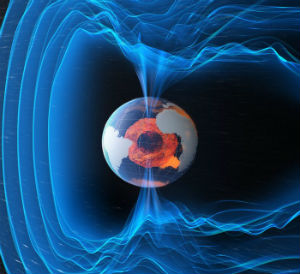
Geophysicists from the University of Rochester studying the 'South Atlantic Anomaly' have recently argued that this observed effect may be connected to pole shifts (3). Historic data collected from this crucial region in Southern Africa showed significant magnetic fluctuations and may be the point from which pole shifts kick off:
"“We were looking for recurrent behavior of anomalies because we think that’s what is happening today and causing the South Atlantic Anomaly,” (Professor John) Tarduno says. “We found evidence that these anomalies have happened in the past, and this helps us contextualize the current changes in the magnetic field.”
"The researchers discovered that the magnetic field in the region fluctuated from 400-450 AD, from 700-750 AD, and again from 1225-1550 AD. This South Atlantic Anomaly, therefore, is the most recent display of a recurring phenomenon in Earth’s core beneath Africa that then affects the entire globe. "We’re getting stronger evidence that there’s something unusual about the core-mantel boundary under Africa that could be having an important impact on the global magnetic field,” Tarduno says." (3)
Deep within the Earth under southern Africa, there exists a dense region of matter known as the 'African Large Low Shear Velocity Province'. A similar phenomemon lies under the Pacific Ocean, with the Earth's core smack bang between them (4). Seismological data suggests that this dense region lies in between the Earth's mantle and its hot liquid outer core. The latter contains the turbulent molten iron which is thought to generate the Earth's magnetic flux. If the dense chunk of matter moves between the layers, bobbing up and down on the welling liquid sea that makes up the core, then that may affect local magnetic conditions and thus create the observed anomaly.
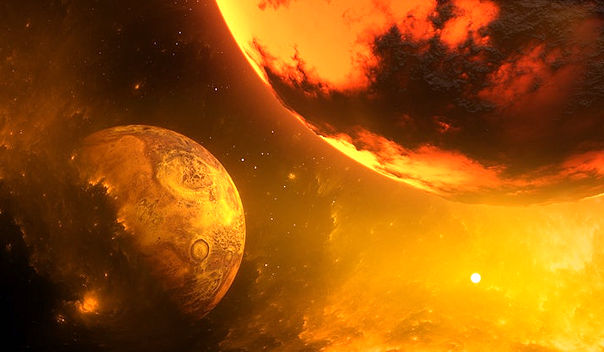
Which brings us back to Theia, or at least what may remain of this proto-planet. In a paper submitted to the 52nd Lunar and Planetary Science Conference, scientists from Arizona State University have suggested that the remnants of the impactor planet Theia are one and the same as the deep, dense chunks lying deep below the Pacific Ocean and the Western side of the African continent (4, 5). This would work if the remnants of the impactor planet were iron rich, and therefore capable of sinking deep through the proto-planet Earth's bulk silicate mantle.
The way the two blobs are aligned either side of the Earth's core suggests the impactor 'bullet' passed clean through the molten core. I imagine Theia impacted the Pacific Ocean side, partially passing through the core and out towards West Africa. This reminds me of the way the Tharsis bulges on Mars look like bullet exit wounds.
Written by Andy Lloyd,
28th October 2021
References:
1)
Andy Lloyd “Moon Even Older than Previously Thought” 30 July 2019andylloyd.org/darkstarblog76.htm
2) Chris Holt “When north goes south: Is Earth's magnetic field flipping?” 14 September 2021
3) University of Rochester Press Release “Earth’s magnetic field fluctuations explained by new data” 27 February 2018
University of Rochester Article
4) Passant Rabie "An Ancient Protoplanet may be Buried Beneath the Pactific Ocean" 29 March 2021, with thanks to Lee
5) Qian Yuan et al “Giant Impact Origin for the Large Low Shear Velocity Provinces” 52nd Lunar and Planetary Science Conference 2021 (LPI Contrib. No. 2548)
The Mysterious Nebra Sky Disk
The British Museum in London have recently announced that their 2022 exhibition on Stonehenge, and the interconnected Palaeolithic peoples living of ancient Europe around the time it was built, would feature the famous Nebra Sky Disk (1).
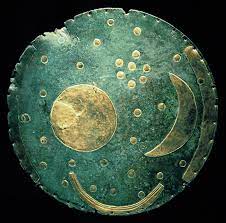
Image credit: D. Bachmann
This wonderful artifact was unearthed in Germany in 1999, and some of my readers remembered me writing about it at the time (2)! The gist of what I wrote was that the historic dating of the Nebra disc coincided with alleged reappearance of Nibiru around 1600 BC - a claim that was doing the rounds back then with respect to a presumed return in our modern times. One might argue that the two crescents indicate a significant 3rd celestial event alongside the more obvious Sun and Moon. At the time they invoked Venus. But allusions to Venus for the second crescent are clearly problematic (how could ancient people make out Venus's crescent shape without binoculars??).
Perhaps the two crescents represent two distinct phases of the Moon,
rather than a usurper object. Or maybe the whole thing is the
visual transition of a total eclipse, or varied partial eclipses of
the Sun or Moon? Who knows. It' remains a great mystery, except to
say that this remarkable bronze age artifact indicates the
importance of the sky to the peoples of that time (as does
Stonehenge itself).
